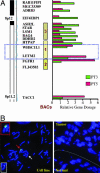High-resolution genomic profiles of human lung cancer
- PMID: 15983384
- PMCID: PMC1160520
- DOI: 10.1073/pnas.0504126102
High-resolution genomic profiles of human lung cancer
Abstract
Lung cancer is the leading cause of cancer mortality worldwide, yet there exists a limited view of the genetic lesions driving this disease. In this study, an integrated high-resolution survey of regional amplifications and deletions, coupled with gene-expression profiling of non-small-cell lung cancer subtypes, adenocarcinoma and squamous-cell carcinoma (SCC), identified 93 focal copy-number alterations, of which 21 span <0.5 megabases and contain a median of five genes. Whereas all known lung cancer genes/loci are contained in the dataset, most of these recurrent copy-number alterations are previously uncharacterized and include high-amplitude amplifications and homozygous deletions. Notably, despite their distinct histopathological phenotypes, adenocarcinoma and SCC genomic profiles showed a nearly complete overlap, with only one clear SCC-specific amplicon. Among the few genes residing within this amplicon and showing consistent overexpression in SCC is p63, a known regulator of squamous-cell differentiation. Furthermore, intersection with the published pancreatic cancer comparative genomic hybridization dataset yielded, among others, two focal amplicons on 8p12 and 20q11 common to both cancer types. Integrated DNA-RNA analyses identified WHSC1L1 and TPX2 as two candidates likely targeted for amplification in both pancreatic ductal adenocarcinoma and non-small-cell lung cancer.
Figures




References
-
- Pao, W. & Miller, V. A. (2005) J. Clin. Oncol. 23, 2556-2568. - PubMed
-
- Minna, J. D., Roth, J. A. & Gazdar, A. F. (2002) Cancer Cell 1, 49-52. - PubMed
-
- Bjorkqvist, A. M., Husgafvel-Pursiainen, K., Anttila, S., Karjalainen, A., Tammilehto, L., Mattson, K., Vainio, H. & Knuutila, S. (1998) Genes Chromosomes Cancer 22, 79-82. - PubMed
-
- Luk, C., Tsao, M. S., Bayani, J., Shepherd, F. & Squire, J. A. (2001) Cancer Genet. Cytogenet. 125, 87-99. - PubMed
-
- Pei, J., Balsara, B. R., Li, W., Litwin, S., Gabrielson, E., Feder, M., Jen, J. & Testa, J. R. (2001) Genes Chromosomes Cancer 31, 282-287. - PubMed
Publication types
MeSH terms
Substances
Grants and funding
LinkOut - more resources
Full Text Sources
Other Literature Sources
Medical
Molecular Biology Databases
Research Materials
Miscellaneous

